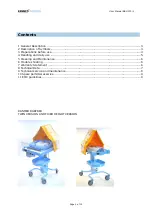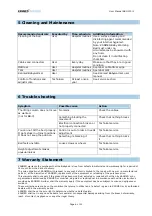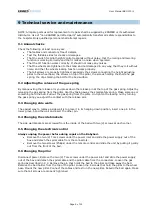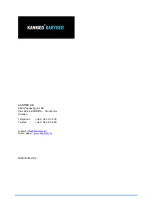
User Manual BB1/070/1
Page 10 of 12
Surge
IEC 61000-4-5
+/- 1 kV differential mode
+/- 2 kV common mode
+/- 1 kV differential mode
n/a. for common mode
Mains power quality should be that of
a typical commercial or hospital
environment.
Voltage dips, short
interruptions and
voltage variations on
power supply input lines
IEC 61000-4-11
<5 % U
T
(>95 % dip in U
T
)
for 0,5 cycle
40 % U
T
(60 % dip in U
T
)
for 5 cycles
70 % U
T
(30 % dip in U
T
)
for 25 cycles
<5 % U
T
(>95 % dip in U
T
))
for 5 sec
<5 % U
T
(>95 % dip in U
T
)
for 0,5 cycle
40 % U
T
(60 % dip in U
T
)
for 5 cycles
70 % U
T
(30 % dip in U
T
)
for 25 cycles
<5 % U
T
(>95 % dip in U
T
))
for 5 sec
Mains power quality should be that of
a typical commercial or hospital
environment. If the user of the
[Equipment or System] requires
continued operation during power
mains interruptions, it is
recommended that the [Equipment or
System] be powered from an
uninterruptible power supply or
battery.
Power frequency (50/60
Hz) magnetic field
IEC 61000-4-8
3 A/m
3 A/m
Power frequency magnetic fields
should be at levels characteristic of a
typical location in a typical
commercial or hospital environment
NOTE U
T
is the a.c. mains voltage prior to application of the test level.
Guidance and manufacturer’s declaration – electromagnetic immunity
The Babybed is intended for use in the electromagnetic environment specified below. The customer or the user of the Babybed
should assure that it is used in such an environment.
Immunity test
IEC 60601 test level
Compliance
level
Electromagnetic environment - guidance
Portable and mobile RF communications equipment should
be used no closer to any part of the Babybed, including
cables, than the recommended separation distance
calculated from the equation applicable to the frequency
of the transmitter.
Conducted RF
IEC 61000-4-6
3 Vrms
150 kHz to 80 MHz
3 Vrms
Recommended separation distance
P
d
2
,
1
=
Radiated RF
IEC 61000-4-3
3 V/m
80MHz to 2,5GHz
3 V/m
P
d
2
,
1
=
80 MHz to 800 MHz
P
d
3
,
2
=
800 MHz to 2,5 GHz
where
P
is the maximum output power rating of the
transmitter in watts (W) according to the transmitter
manufacturer and
d
is the recommended separation
distance in meters (m).
Field strengths from fixed RF transmitters, as determined
by an electromagnetic site survey,
a
should be less than
the compliance level in each frequency range.
b
Interference may occur in the vicinity of equipment
marked with the following symbol.
NOTE 1 At 80MHz and 800MHz, the higher frequency range applies.






























